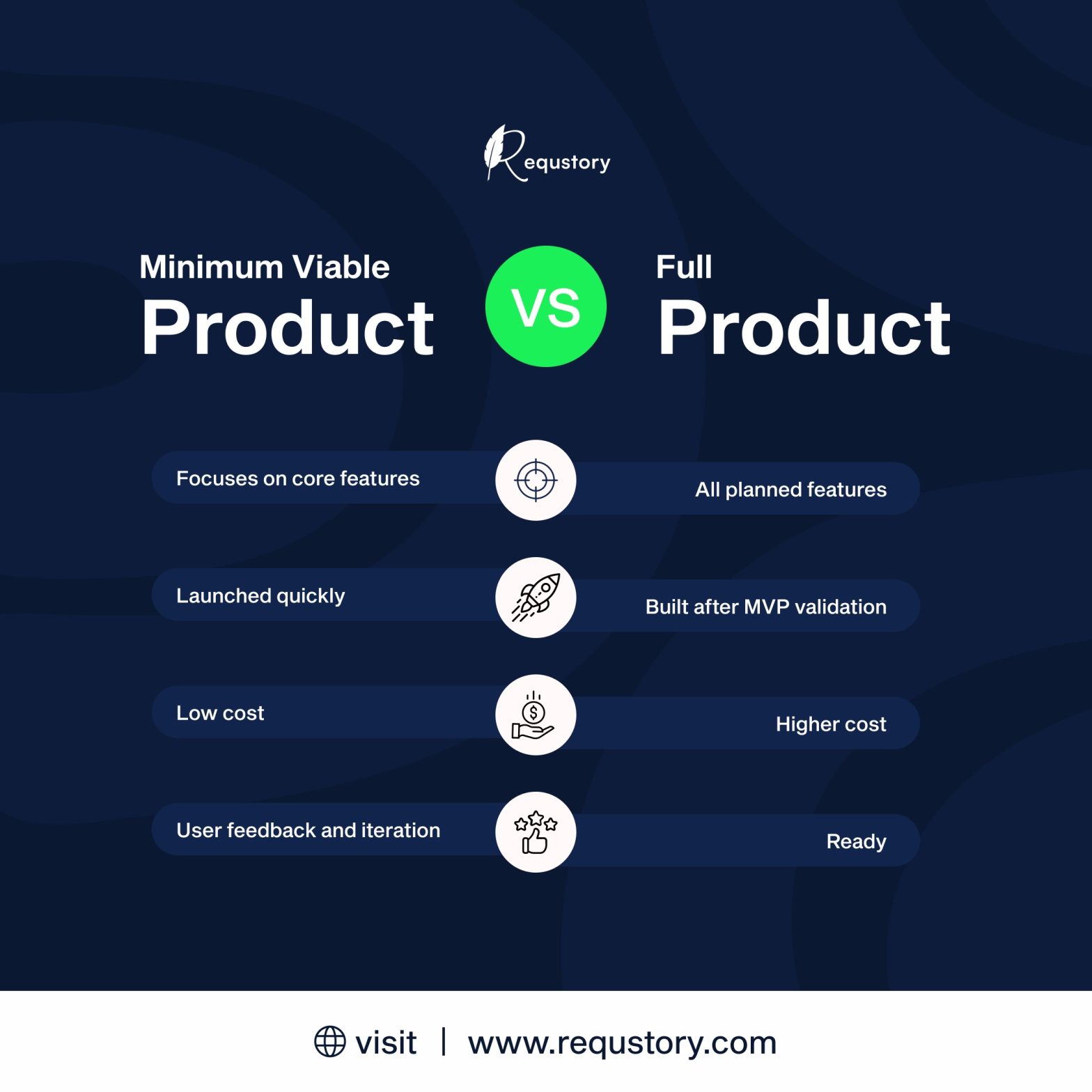Introduction
In the world of product development, one of the biggest challenges is deciding whether to build a full product right away or start with a Minimum Viable Product (MVP). While a full product might seem like the ultimate goal, beginning with an MVP is often the smarter, more efficient approach. This blog will explore the differences between an MVP and a full product, the benefits of starting small, and how leveraging tools like Requstory can streamline the process.
What Is an MVP?
An MVP, or Minimum Viable Product, is a scaled-down version of a product that includes only the core features necessary to satisfy early users. The goal of an MVP is to launch quickly, gather user feedback, and iterate based on real-world insights.
Characteristics of an MVP:
Focuses on solving one main problem.
Built with minimal resources and time.
Prioritizes functionality over perfection.
Examples of Successful MVPs:
Airbnb: Started as a simple website for short-term home rentals.
Dropbox: Launched with an explainer video showcasing its core functionality.
What Is a Full Product?
A full product is the complete version of your idea, equipped with all the planned features, polished design, and a full-scale implementation. Unlike an MVP, a full product requires extensive time, resources, and market analysis to develop.
Characteristics of a Full Product:
Includes advanced features and integrations.
Targets a broader audience.
Aims for scalability and long-term market presence.
MVP vs. Full Product: Key Differences
When comparing an MVP to a full product, here are the major distinctions to consider:
Development Time
MVP: Quick to develop, typically taking weeks to months.
Full Product: Requires extensive time, often months or years, due to the need for advanced features and polish.
Features
MVP: Focuses only on core features necessary to address the primary problem.
Full Product: Offers a comprehensive feature set, often including advanced functionalities.
Cost
MVP: Significantly more affordable to build since it only includes the essentials.
Full Product: Demands a higher investment due to its complexity and scale.
Risk
MVP: Lower risk since it can be iterated based on user feedback and market performance.
Full Product: Higher risk because of the time and resources committed before market validation.
Feedback
MVP: Designed to collect real-time user feedback for continuous improvement.
Full Product: Limited initial feedback due to its larger scale and longer development cycle.
Why Starting Small with an MVP Is the Smartest Move
1. Validates Market Demand
An MVP helps determine whether your product idea resonates with your target audience. By launching a basic version, you can test the waters and make data-driven decisions for future iterations.
Keywords:
AI-driven requirements management
Efficient user story creation
2. Reduces Development Costs
Building a full product from the start requires a significant investment in time and money. With an MVP, you can launch with fewer resources and scale as you gather user insights.
Keywords:
Streamlined project requirement tools
Agile project planning software
3. Speeds Up Time to Market
An MVP allows you to enter the market faster, giving you a competitive edge. Early entry enables you to establish your product while competitors are still in development.
Keywords:
Agile requirements gathering
Digital transformation in project management
4. Encourages Iterative Development
User feedback from an MVP allows you to improve your product continuously. This iterative approach ensures your final product meets real user needs and minimizes the risk of failure.
Keywords:
Collaborative project management tools
Interactive process mapping
5. Minimizes Risk
Starting small reduces the risk of building a product that fails to resonate with your audience. An MVP approach ensures that every step of development is backed by validated insights.
How to Build a Successful MVP
1. Define the Problem
Clearly outline the problem your MVP aims to solve. This clarity ensures that your core features align with user needs.
2. Focus on Core Features
Avoid feature creep by prioritizing functionality that delivers the most value to your target audience.
3. Use Prototyping Tools
Leverage tools like Requstory to create user stories, process maps, and prototypes that visualize your MVP’s workflows and design.
Keywords:
Prototyping tools for Business Analysts
AI-powered project documentation
4. Gather User Feedback
Launch your MVP to a small group of users and collect feedback on their experience. Use this data to refine your product before expanding.
Transitioning from MVP to Full Product
Once your MVP has proven successful, transitioning to a full product becomes more manageable. Use the insights gathered from your MVP to:
Expand features based on user demand.
Improve product design and usability.
Scale your operations to reach a larger audience.
Keywords:
Agile workflow automation
Business process modeling tools
How Requstory Simplifies MVP Development
Requstory is an AI-powered platform tailored to assist in the development of both MVPs and full products. Here’s how it supports your journey:
User Story Mapping: Quickly define core features and visualize workflows.
Process Mapping: Create detailed diagrams to ensure all functionalities align with user needs.
Collaboration Tools: Work seamlessly with your team in real-time to streamline MVP development.
Iterative Development: Use Requstory’s tools to gather feedback and continuously improve your product.
By leveraging Requstory, you can save time, reduce costs, and ensure your MVP is well-positioned for success. Learn more about Requstory.
FAQs
1. How do I decide between building an MVP or a full product?
Start with an MVP if you’re testing a new idea or entering an uncertain market. A full product is ideal when you have a proven market demand and ample resources.
2. How much should I invest in an MVP?
The cost of an MVP depends on its complexity and the tools you use. Start with essential features to keep costs low and focus on validating your idea.
3. How can I ensure my MVP meets user needs?
Leverage tools like Requstory to create user stories, process maps, and prototypes that align with your target audience’s requirements.
Conclusion
Building a product doesn’t have to be an all-or-nothing endeavor. Starting small with an MVP allows you to validate your idea, save resources, and minimize risks. As you refine your product based on user feedback, transitioning to a full product becomes more seamless and effective.
Ready to take your idea from concept to reality? Start using Requstory today to simplify your MVP development and set your product up for long-term success!

